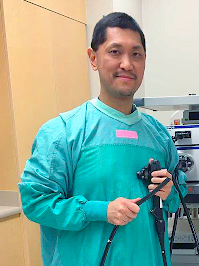Earlier in the day, five-year-old Annabel had a regular morning and afternoon. She attended a birthday party and seemed to be herself, laughing with her friends and running around. At 0200 and Annabel calls for her mom, crying and clutching her stomach. Her mom rushes into her daughter’s room and finds Annabel in significant pain. Annabel is rushed to the hospital at 0400. At triage, she is in significant discomfort, crying, and tachycardic. The rest of her vitals are within normal limits.
Annabel’s mom explains that her daughter was well yesterday before complaining of some vague abdominal discomfort prior to going to bed. Her mom figured it was just the cake from the birthday party earlier that day.
A more thorough history reveals an otherwise well child, who has no ongoing chronic medical conditions, no ongoing medications, and no allergies. She did have surgery as a newborn for a significant ventral hernia, however, she has not had any issues with this since. Annabel last ate at 1600 at the birthday party. She has not had a bowel movement in 24 hours, which is unusual for her. She is unable to tell you if she has been passing gas. She denies any urinary complaints. Her mom denies Annabel having any discolored stool, but mentions that Annabel did have one bout of non-bloody emesis in the car on the way to the hospital.
A physical exam reveals a distressed child, who is crying in the exam room. An abdominal exam reveals a distended abdomen that is slightly firm, with no rebound tenderness or guarding suggestive of peritonitis.
Background
Small bowel obstruction (or SBO) should be on the differential for any adult or child that presents with abrupt onset of abdominal pain, nausea, vomiting, obstipation (inability to pass stool or flatus), and abdominal distention. The lack of any of these symptoms does not exclude the diagnosis; one study found that the classic symptoms of diffuse abdominal pain, nausea, vomiting, and constipation were not more predictive of an obstruction than diffuse tenderness or distended abdomen.1 One should be particularly wary of obstipation, as stool and flatus may pass for 12-24 hours after the onset of obstruction.
SBO has multiple etiologies. In general, it is broken into two broad categories: functional (also known as ileus) or mechanical.
In adults, the top three causes of SBO can be remembered with “ABC”, standing for 1. Adhesions, 2. Bulges (hernias), 3. Cancer. When taking a history, one MUST ask about prior abdominal surgeries. Further important risk factors include: inflammatory bowel disease (eg. Crohn disease), prior abdominal radiation, or history of foreign body ingestions.
In pediatric patients, the causes of SBO vary slightly from those of adults. In one study, intussusception, adhesions, and irreducible inguinal hernias were found to be the most common pathologies for SBO.2 Additional unique causes can be found in pediatric patients not infrequently, including Meckel’s diverticulum and congenital adhesive bands.2
SBO can result in bowel ischemia, perforation, and necrosis,3 and thus should not be taken lightly. Clinical findings suggestive of these more severe consequences include high fever, localized severe abdominal tenderness, rebound tenderness or other signs of peritonitis, severe leukocytosis, or metabolic acidosis.4 Closed-loop obstruction frequently presents with pain out of proportion to the abdominal signs, due to concurrent mesenteric ischemia.4
Basic Clinical Approach
It is imperative that one differentiates between complete SBO and partial or pseudo-SBO, as complete obstruction always warrants immediate surgical intervention.4
Although a general surgical consultation is always warranted in the case of suspected or proven SBO, surgical management should be considered second-line to conservative management.5
Investigations
Labs
No lab test reliably predicts SBO. However, serum bicarbonate level, arterial blood pH, and lactate can assist in diagnosing intestinal ischemia.4 Numerous prospective studies have investigated the use of lactate in diagnosing mesenteric ischemia, with the general consensus that the specificity (~30%) and sensitivity (~30-70%) are too low to consistently diagnose mesenteric ischemia.6 A β-HCG should always be ordered in women of childbearing age. A urinalysis/urine can be helpful to rule out pyelonephritis or a UTI.
A coagulation profile, including INR, PTT, and platelet count, should be determined because of the potential need for surgery.
Imaging
Plain film abdominal x-rays are the quickest modality used to evaluate SBO in centers with limited resources or access to CT, however, the imaging test of choice is CT with contrast if available. Additionally, there is some utility for point of care ultrasound (POCUS) in the hands of well-trained ED physicians. One prospective, randomized trial found that POCUS had an overall sensitivity of 88%.7 Findings significant for SBO on ultrasound included bowel dilation >25mm, abnormal peristalsis, transition point, small bowel wall edema, and intraperitoneal free fluid. 7
Note for pediatrics (as in this case)
In pediatric patients, the goal is to obtain the best imaging so as to obtain a diagnosis, while limiting radiation exposure. If expertise is available, an ultrasound may be an option, however, this expertise for deciphering pediatric SBO on ultrasound is very limited. A plain film abdominal x-ray is often the modality of choice. One should note that a paucity of air does not exclude the possibility of a SBO; if the patient has a clinical picture suggestive of SBO, a closed-loop or high-grade obstruction should be considered in this case.8 Urgent referral to general surgery is often warranted early on in the workup of a pediatric patient with suspected bowel obstruction. Should there still be questions regarding whether surgical intervention is needed, a follow-up CT scan may be ordered to clarify the presence, extent, and cause of SBO.8 When needed, CT in children does have its merits; one study found that CT had 87% sensitivity and 86% specificity for diagnosing small bowel obstruction in children.9 Ultrasound also has its diagnostic utility in pediatric patients, as it has nearly 100% sensitivity and specificity of diagnosing intussusception, a common cause of SBO in pediatric patients, in the hands of an experienced ultrasonographer.10
| Imaging Modality | Xray | CT abdo | Ultrasound |
| Benefits | Widely available, inexpensive, potentially less radiation***, can show need for urgent decompression/surgical intervention | Better for identifying transition point and severity of obstruction, etiology, complications (ischemia, necrosis, perforation)→with contrast increases the benefit of CT | Useful in young, pregnant patients, or those who have contrast allergies, critically ill. Widely available, no radiation. |
| Drawbacks | Cannot establish a transition point, may give normal image despite presence of SBO | Higher radiation (consideration particularly in young patients, pregnant), less available in rural centres | Gas-filled structures can limit visualization, also difficult to determine location of SBO |
| Findings | Dilated loops of bowel with air-fluid levels, proximal bowel dilation with distal bowel collapse (proximal small bowel >2.5cm), gasless abdomen (“string of beads sign”) | Bowel wall thickening >3mm, submucosal edema/hemorrhage, mesenteric edema, ascites. Target Sign: indicates intussusceptionWhirl Sign: twist or volvulusVenous cut-off sign: thrombosis →intraperitoneal free fluid with Hounsfield Unit >10 is highly suggestive of the need for operative intervention.11 | Bowel dilation >25mm, abnormal peristalsis, transition point, small bowel wall edema, and intraperitoneal free fluid (Becker et al., 2019). |
| Sensitivity/Specificity | Sensitivity: 79-83%Specificity: 67-83% | Sensitivity: 90-04%Specificity: 96%**For high grade SBO.12 | Sensitivity: 75%Specificity: 75% |
***It is well known that children are more sensitive to the effects of ionizing radiation than adults,13 however, new CT technologies have decreased the radiation dose needed, creating weight-based dosing that can decrease radiation exposure by up to 90%,14 making the radiation only minimally higher than an x-ray.
Management
- Fluid resuscitation (generally with a crystalloid such as Ringers lactate or normal saline), as well as pain management in the ED. Admission is warranted, likely under the general surgery team.
- Patients should remain NPO.
- In uncomplicated SBO, prophylactic antibiotics are not recommended.
- NG tube: Use of NG may be hospital and provider specific, however it is still recommended by general surgeons. It has been well shown to have benefit in those who are symptomatic, as well as decreasing aspiration events in those that may ultimately end up with surgical intervention. In those who are asymptomatic, it is up to provider discretion. See a summary of this topic at EM Cases.
NG tube insertion is often poorly tolerated by patients. A number of studies have found ways to improve the tolerance of this procedure: A meta-analysis conducted by Cao et al. found that application of a topical lidocaine spray prior to insertion had significant benefit for patient’s comfort, without increasing adverse events.14 Another double-blind randomized controlled study found that premedication, using 2 mg of IV midazolam reduced the pain of NG tube insertion.14
- General surgery consultation after imaging. Operative management and/or admission under general surgery for conservative management may be indicated. In children, in particular, the etiology of SBO can dictate the likelihood of operative management being needed. One study found that specifically, children under 1 year of age, as well as those with Hirschsprung׳s disease or intussusception, had a lower success rate of conservative management. 15
Conservative management often includes the use of water-soluble contrast, which can be both diagnostic and therapeutic. Gastrografin is often used, which is a hyperosmotic solution composed of sodium diatrizoate and meglumine diatrizoate.16 A recent study found that patients who received Gastrografin under an implemented Gastrografin protocol had a shorter length of stay in hospital and were less likely to undergo surgical intervention.17 Notably, this protocol included that patients should have 12 hours of NG decompression before starting the Gastrografin.
Conservative vs operative management
Standard conservative management typically includes: fluid and electrolyte resuscitation, NG decompression and bowel rest (NPO), and is roughly 80% successful in patients with partial obstruction.18 Generally, conservative management is not trialed for longer than 3-5 days.
Back to the case
A bedside ultrasound for Annabel unfortunately does not reveal any acute abnormalities. And neither does a plain film abdominal x-ray. You consult general surgery, who reviews her case. Ultimately, the decision is made to have her undergo an abdominal CT scan to evaluate whether or not her symptoms may be explained by a SBO, given her prior abdominal surgical history and the increased risk for adhesions.
A CT scan shows a partial small bowel obstruction with prominent air-fluid levels. You pass her care to the general surgery team, who ultimately will determine whether conservative or surgical management will be pursued. In the meantime, you start her on IV fluid resuscitation and provide IV analgesia to keep her comfortable.
Later that evening, Annabel went on to have emergency surgery. It was lucky that the obstruction was caught, as during surgery, it was found to be more serious than imaging had originally suggested and Annabel was at risk of perforation. She is recovering well on the ward and will be referred to a pediatric gastroenterologist as there was some uncertainty of her nutrition status. Her parents are very grateful for the care that she’s received!
Main Points
- The top 3 causes of small bowel obstruction include ABC: Adhesions, Bulges (hernias), Cancer
- It is critical to decipher partial vs complete bowel obstruction for management
- Clinical findings include pain, nausea, vomiting, abdominal distention, and obstipation (beware!)
- Imaging: Plain film abdominal x-rays are the quickest modality used to evaluate SBO. However, CT scan is preferred if available. POCUS may also play a role in some centres and patient populations.
- General surgery consultation is warranted whenever SBO is suspected. However, partial obstructions may be trialed with a conservative management approach first. In ED, pain management and fluid resuscitation is imperative, this often includes insertion of an NG tube.
This post was copyedited by Joe Boyle.
References
- 1.Jang T, Schindler D, Kaji A. Predictive value of signs and symptoms for small bowel obstruction in patients with prior surgery. Emerg Med J. 2012;29(9):769-770. doi:10.1136/emj.2010.100594
- 2.Houben CH, Pang KK, Mou WC, Chan KW, Tam YH, Lee KH. Epidemiology of small-bowel obstruction beyond the neonatal period. Annals of Pediatric Surgery. Published online July 2016:90-93. doi:10.1097/01.xps.0000481055.24776.db
- 3.Markogiannakis H, Messaris E, Dardamanis D, et al. Acute mechanical bowel obstruction: clinical presentation, etiology, management and outcome. World J Gastroenterol. 2007;13(3):432-437. doi:10.3748/wjg.v13.i3.432
- 4.Cappell M, Batke M. Mechanical obstruction of the small bowel and colon. Med Clin North Am. 2008;92(3):575-597, viii. doi:10.1016/j.mcna.2008.01.003
- 5.Dong X, Huang S, Jiang Z, Song Y, Zhang X. Nasointestinal tubes versus nasogastric tubes in the management of small-bowel obstruction: A meta-analysis. Medicine (Baltimore). 2018;97(36):e12175. doi:10.1097/MD.0000000000012175
- 6.Demir I, Ceyhan G, Friess H. Beyond lactate: is there a role for serum lactate measurement in diagnosing acute mesenteric ischemia?. Dig Surg. 2012;29(3):226-235. doi:10.1159/000338086
- 7.Becker B, Lahham S, Gonzales M, et al. A Prospective, Multicenter Evaluation of Point-of-care Ultrasound for Small-bowel Obstruction in the Emergency Department. Acad Emerg Med. 2019;26(8):921-930. doi:10.1111/acem.13713
- 8.Johnson B, Campagna G, Hyak J, et al. The significance of abdominal radiographs with paucity of gas in pediatric adhesive small bowel obstruction. Am J Surg. 2020;220(1):208-213. doi:10.1016/j.amjsurg.2019.10.035
- 9.Jabra A, Eng J, Zaleski C, et al. CT of small-bowel obstruction in children: sensitivity and specificity. AJR Am J Roentgenol. 2001;177(2):431-436. doi:10.2214/ajr.177.2.1770431
- 10.Li X, Wang H, Song J, Liu Y, Lin Y, Sun Z. Ultrasonographic Diagnosis of Intussusception in Children: A Systematic Review and Meta-Analysis. J Ultrasound Med. 2021;40(6):1077-1084. doi:10.1002/jum.15504
- 11.Matsushima K, Inaba K, Dollbaum R, et al. High-Density Free Fluid on Computed Tomography: a Predictor of Surgical Intervention in Patients with Adhesive Small Bowel Obstruction. J Gastrointest Surg. 2016;20(11):1861-1866. doi:10.1007/s11605-016-3244-6
- 12.Mallo R, Salem L, Lalani T, Flum D. Computed tomography diagnosis of ischemia and complete obstruction in small bowel obstruction: a systematic review. J Gastrointest Surg. 2005;9(5):690-694. doi:10.1016/j.gassur.2004.10.006
- 13.Goodman T, Mustafa A, Rowe E. Pediatric CT radiation exposure: where we were, and where we are now. Pediatr Radiol. 2019;49(4):469-478. doi:10.1007/s00247-018-4281-y
- 14.Manning C, Buinewicz J, Sewatsky T, et al. Does Routine Midazolam Administration Prior to Nasogastric Tube Insertion in the Emergency Department Decrease Patients’ Pain? (A Pilot Study). Acad Emerg Med. 2016;23(7):766-771. doi:10.1111/acem.12961
- 15.Vijay K, Anindya C, Bhanu P, Mohan M, Rao P. Adhesive small bowel obstruction (ASBO) in children–role of conservative management. Med J Malaysia. 2005;60(1):81-84. https://www.ncbi.nlm.nih.gov/pubmed/16250285
- 16.Burge J, Abbas S, Roadley G, et al. Randomized controlled trial of Gastrografin in adhesive small bowel obstruction. ANZ J Surg. 2005;75(8):672-674. doi:10.1111/j.1445-2197.2005.03491.x
- 17.Zhou C, Udwadia F, Chen L, Joos E. Using Gastrografin to manage adhesive small bowel obstruction: A nonrandomized controlled study with historical controls. BCMJ. 2021;63(6):247-251. https://bcmj.org/articles/using-gastrografin-manage-adhesive-small-bowel-obstruction-nonrandomized-controlled-study
- 18.Köstenbauer J, Truskett P. Current management of adhesive small bowel obstruction. ANZ J Surg. 2018;88(11):1117-1122. doi:10.1111/ans.14556
Reviewing with the Staff
“Small bowel obstruction” encompasses a diverse group of patients who are managed with everything from discharge from the ED to immediate surgery. This summary provides a good approach. The important take home is that there is no universal management plan; every patient must be evaluated individually. If you are uncertain whether an NG tube is required before a CT is done or are worried about your patient, please call your friendly neighborhood general surgeon early to review the case.





